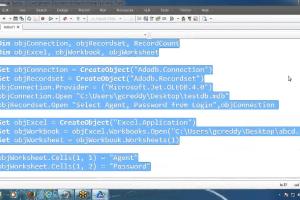Mastering VBScript: An In-Depth Guide to Programming with VBScript

-
Quick Links:
- 1. Introduction to VBScript
- 2. History of VBScript
- 3. Setting Up Your Environment
- 4. Basic Syntax and Structure
- 5. Working with Variables
- 6. Control Structures
- 7. Functions and Subroutines
- 8. Error Handling in VBScript
- 9. File Handling with VBScript
- 10. Real-World Case Studies
- 11. Common Issues and Troubleshooting
- 12. FAQs
- 13. Conclusion
1. Introduction to VBScript
VBScript, short for Visual Basic Scripting Edition, is a scripting language developed by Microsoft. It is primarily used for automation in web applications and Windows environments, facilitating tasks such as data validation, server-side scripting, and client-side scripting in HTML. Its ease of use and integration with other Microsoft products make it a popular choice for both beginners and seasoned programmers.
2. History of VBScript
VBScript was first introduced in 1996 as a lightweight scripting language designed to be embedded in HTML pages. Over the years, it has evolved, gaining features and functionalities that make it suitable for a variety of applications. This section will explore VBScript's development timeline and its significance in the programming world.
3. Setting Up Your Environment
Before diving into programming with VBScript, you need to set up your environment. This includes selecting the right text editor and ensuring that your system is configured to execute VBScript files. Here’s how to get started:
- Choose a Text Editor: You can use simple editors like Notepad or more advanced ones like Visual Studio Code.
- Enable Scripting: Make sure that scripting is enabled on your Windows machine. This can usually be done through the Windows settings or group policy.
- Write Your First Script: Start with a simple Hello World script to ensure everything is working correctly:
MsgBox "Hello, World!"4. Basic Syntax and Structure
Understanding the syntax is crucial for writing effective VBScript code. This section will cover:
- Comments: How to add comments in your code.
- Data Types: Overview of different data types in VBScript.
- Operators: Arithmetic, comparison, and logical operators.
5. Working with Variables
Variables are essential for storing data in your scripts. This section will outline:
- Declaring Variables: Using
Dim,Public, andPrivate. - Variable Scope: Understanding local and global variables.
- Dynamic Typing: How VBScript handles variable types dynamically.
6. Control Structures
Control structures allow you to dictate the flow of your program. This includes:
- If...Then...Else statements
- Select Case statements
- Loops: For...Next, Do...Loop, and While...Wend
7. Functions and Subroutines
Functions and subroutines are vital for structuring your code efficiently. This section covers:
- Defining Functions: How to create and call functions.
- Passing Arguments: How to pass parameters to functions.
- Returning Values: How to return values from functions.
8. Error Handling in VBScript
Handling errors is crucial for creating robust scripts. This section will explain:
- Using On Error Resume Next
- Identifying and Managing Errors
- Logging Errors for Debugging
9. File Handling with VBScript
File handling capabilities allow you to read from and write to files. Key topics include:
- Opening and Closing Files
- Reading and Writing Data
- File System Object (FSO): Using FSO for file operations
10. Real-World Case Studies
To understand the practical applications of VBScript, we will explore several case studies:
- Case Study 1: Automating Report Generation in Excel
- Case Study 2: Creating Interactive Web Forms
- Case Study 3: System Maintenance Scripts for IT Departments
11. Common Issues and Troubleshooting
Even experienced developers encounter issues. This section will provide solutions to common problems users face when programming with VBScript:
- Debugging Techniques
- Common Error Messages and Their Solutions
- Performance Optimization Tips
12. FAQs
Q1: What is VBScript used for?
A1: VBScript is primarily used for automating tasks in Windows environments and creating dynamic web pages.
Q2: Is VBScript still relevant?
A2: While VBScript is less common due to the rise of other scripting languages, it is still used in legacy systems.
Q3: Can VBScript be used in modern web applications?
A3: VBScript is not supported in modern browsers but can be used in legacy applications.
Q4: How do I debug a VBScript?
A4: You can use the built-in debugger in Windows Script Host or utilize MsgBox for displaying variable values.
Q5: What are some alternatives to VBScript?
A5: Alternatives include PowerShell, JavaScript, and Python, which offer more modern features and broader community support.
Q6: Can I use VBScript for web development?
A6: Yes, but only in Internet Explorer. Modern web applications typically use JavaScript.
Q7: Is VBScript case-sensitive?
A7: No, VBScript is not case-sensitive.
Q8: How do I create functions in VBScript?
A8: Use the Function keyword followed by the function name and parameters.
Q9: Can I use VBScript to manipulate files?
A9: Yes, you can manipulate files using the File System Object (FSO).
Q10: Where can I learn more about VBScript?
A10: Numerous online resources, tutorials, and documentation are available, including Microsoft's official documentation.
13. Conclusion
VBScript may not be the most modern scripting language, but its simplicity and integration with Windows make it a valuable tool for automation and scripting. By mastering VBScript, you can enhance your programming skills and open up new opportunities for automation in your work environment.